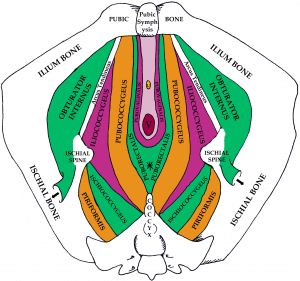As you know, I’m a huge fan of the human body and its amazing capabilities. Did you know, for example, that human bone is as strong as granite, or that humans are bioluminescent and glow in the dark? (Thanks Distractify).
But, as per my job, I’m also fascinated in hunting down how ours tend to ‘let us down’, break, weaken, fade, and how so many of us leave physical problems until they have become not just bad, but intolerable, before seeking help.
This month, I’ve begun my journey into women’s health physiotherapy, refreshing my existing knowledge and attending some eye-opening, eyebrow-raising and leg-crossing courses. Pelvic floors, anal winks, divided ligaments, stress incontinence. It’s tough being a woman, and it sent me home with a renewed appreciation of all my friends who are mums, as well as my own mother, who grew and raised four of us. If you need any convincing of how stupendously amazing our bodies are, just find stuff out about pregnancy and foetal development. Mind blowing.
There are two bits of info I’d like to share with you to help you or your loved ones understand what’s going on – both in the pelvis and how it relates to the rest of your body (nevermore shall we consider our bits to be separate!).
No Special Treatment
Firstly, from a physio perspective when delving into the unknown deep (literally), my most useful revelation so far was to realise that the whole pelvic area, (so taboo!) is bones, muscles and nerves… just like the rest of our bodies.
The muscles get tired, torn, imbalanced, over- or under-used, nerves get irritated, joints take the strain and start to show it. Yes, there are added complications for sure, and it’s a ‘special area’, but it’s still part of our bodies, and deserves the same care and attention. And it’ll respond to similar rehabilitation – with a healthy dose of self-kindness and appreciation.
Perhaps the biggest problem is that it’s the area most likely to be ignored, for the sake of politeness. I’ve met women who have been incontinent for twenty years, without their husband knowing, and tragically, without knowing there are ways to tackle the problem. I’ve met new mums enduring undignified leakage, pain during sex, ignored organ prolapses because they have been told ‘that’s just being a mother’. It may be hugely common, but it’s not, or shouldn’t be ‘normal’. Our pelvis has just the same potential for recovery and optimum health as any other part of our body.

Firstly, what are we talking about when we hear whisper of the dreaded Pelvic Floor? Essentially, it’s the collective name for the layers of muscles that sling across our inner pelvis, supporting our pelvic organs and controlling continence. It maintains intra-abdominal pressure during every breath, cough or sneeze we make, and plays the other crucial role of rotating the foetus’ head during labour, working with and against those enormous pressures of contractions and the mother bearing down.
Here’s a steady, hugely informative 3-D video on the anatomy, functions and potential dysfunctions:
Take a Deep Breath…
The second area, and this links to all sorts of things like yoga, meditation and engineering, is how the diaphragm and the pelvic floor have to be synchronised for all the above pelvic floor tasks to be achievable. Another little light-bulb moment came when I realised all this lifting and squeezing and tightening women are encouraged to do often ignores any need to stretch, relax and rest.
If we just did pull ups, bringing our arms into a tight flexed position repeatedly and against load, chances are we’d end up being very tight and hugely ineffective at other things are arms are used for and we’d desperately need a good, gentle, long stretch. Our pelvic floor muscles are no different.
We all have been told how slow, tummy breathing is good for us (stimulates ‘rest and digest’ nervous systems, calms the mind) but here is a lovely blog about how it connects to the pelvic floor: The Incredible Rightness of Breathing.
The video below, though not that great quality, is a really simple way to show how our breathing diaphragm pushes downwards on inhalation and relaxes upwards on exhalation, and how the pelvic floor, in a health person, should respond. All sorts of dysfunctional breathing can disrupt this and open up the opportunity for injury. You can read more on breathing in my blog Every Breath You Take.
And remember – this is not just for girls. If anything, men put their bodies through greater loading and exertion than women (on average, aside from childbearing) and breathe just the same. Jumping, weight-lifting, even that deep roaring laugh all challenge their pelvic floor just the same. They are even less likely to go for help with issues of incontinence or sexual dysfunction. Yet they have almost all the same bits as us, with an obvious exception. So pass it on, speak out loud, talk to others – they may be suffering too. If something’s not working, it can get better. Ask for help. You will receive it.